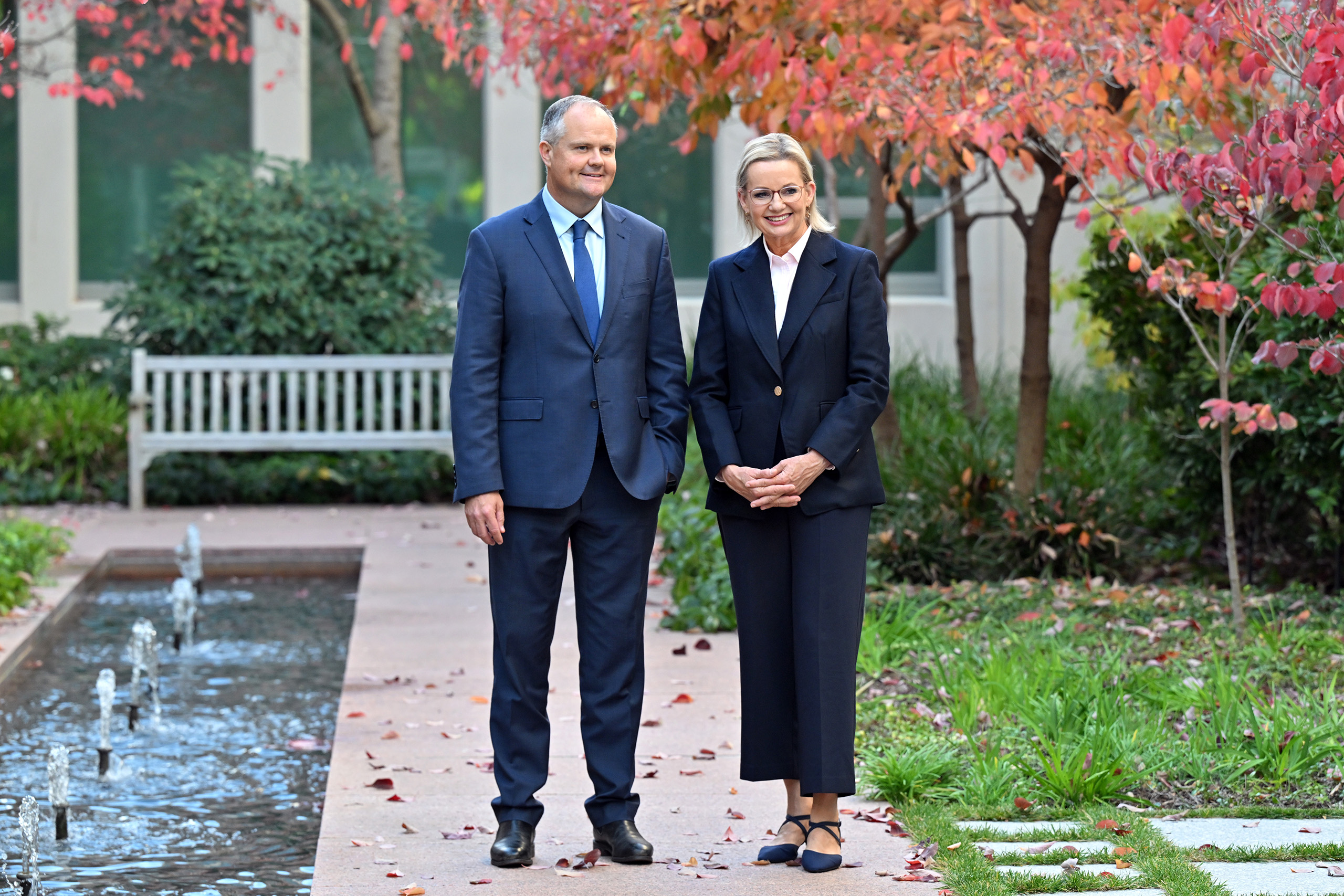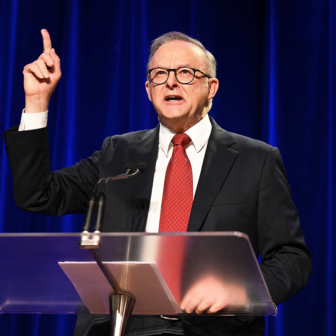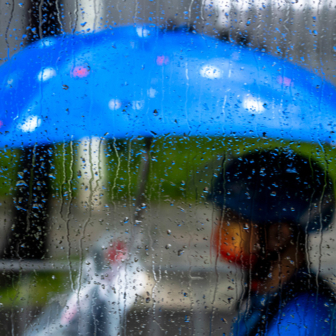No single factor determines a political leader’s success. But how they got there is certainly material.
This is why the new federal Liberal leader, Sussan Ley, will spend the next three years looking over her shoulder, if she lasts that long.
That may seem harsh and even unfair, given Ley’s CV attests to her resilience and a slew of personal accomplishments, not least that she has just been elected the Liberals’ first female leader, indeed the first woman ever to head a federal opposition in Australia.
Ley deserves the accolades due to a ground-breaker, given that women so often still only get tapped when there’s a mess to clean up. That she was willing to fight for the job in the shadow of a catastrophic loss should also entitle her to a decent shot at pulling her smashed-up party together and pointing it towards the next election.
And so far, so good. Her first news conference as leader this week, with conservative deputy Ted O’Brien alongside, was a calm and controlled mix of reflection, optimism and political attack. If she continues like that, she’ll significantly increase her chances of reversing the party’s fortunes and surviving in the job. But the inflammatory defection of Senator Jacinta Nampijinpa Price — lured from the Nationals to the Liberals by the prospect of becoming deputy to conservative leadership contender Angus Taylor, only to have him fail and her baulk — shows the party’s right doesn’t exactly consider the election loss a rebuke of its ideas.
Strong public performance is the best way for Ley to neutralise the internal forces that are clearly prepared to marshal against her. But only three votes need to switch for her to be out, and she’s losing at least two when senators Hollie Hughes and Linda Reynolds retire in July.
None of this suggests the road ahead will be smooth.
To understand why the right of the Liberal Party is unlikely, at this point, to commit to Sussan Ley’s success, it’s worth strolling through the history of her relationship with its former chief Peter Dutton, the man she has succeeded.
It’s almost eight years since Dutton’s failed first prime ministerial bid, when he moved against incumbent Malcolm Turnbull at the bitter end of winter in 2018. Turnbull won that first party-room vote but the challenger’s strong support — it was forty-eight to thirty-five — guaranteed it wasn’t over. Dutton’s immediate resignation and move to the backbench confirmed it.
Even though he’s now gone, the way things unfolded then may yet have a bearing on how they’ll go, eight years on.
That August week in 2018, a cascade of other ministerial resignations upped the pressure on the prime minister. Dutton tried again two days later but Turnbull refused to call a spill unless he sighted a majority petition, signed by at least forty-three Liberals, which would effectively signal no confidence and trigger a vote on whether to declare his job vacant. If the petition materialised and the vote passed, Turnbull vowed he wouldn’t contest the ensuing leadership ballot.
It’s the 2018 petition that underpins Sussan Ley’s current vulnerability. It didn’t cost just Turnbull the prime ministership but, at the time, Dutton too. While much of the media focus was on several signatories who scribbled explanatory notes beside their names, the order in which it was signed seems like the real story.
Number one was Andrew Hastie. The former special forces soldier turned MP had been recruited under Tony Abbott’s prime ministership to contest the September 2015 by-election in the WA seat of Canning when incumbent Don Randall died suddenly. Five days before the young conservative Hastie faced voters, moderate-aligned Malcolm Turnbull ousted conservative Abbott. In being the first petitioner three years later, Hastie didn’t have to spell out the message he was sending.
Second to sign was South Australian Tony Pasin, who remains a key member of the hard right and was a Dutton backbench lieutenant. The third signatory was Sussan Ley.
Like Hastie, Ley had personal reasons for moving against Turnbull. She’d been aligned with his moderates but he’d forced her to quit the ministry the previous year over a travel rorts scandal. It emerged in January 2017 that she’d taken a government car from her Gold Coast hotel to a property auction, and then bought an apartment, during an official trip as health minister in May 2015. A finance department investigation found no other transgressions but confirmed the Gold Coast car trip was outside the rules. Ley reimbursed the Commonwealth, adding a voluntary 25 per cent penalty, but paid a bigger price for becoming a political liability.
Before the furore, Turnbull had privately criticised Ley’s ministerial chops when he’d almost lost the 2016 election after Bill Shorten’s Labor ran its “Mediscare” campaign claiming — without evidence — that a returned Coalition government would privatise the health system. Her demotion was for the travel but Ley considered the penalty unwarranted and suspicious.
“When I resigned as minister, I did so because the facts could not overcome the story,” she told parliament, tabling the confidential Finance report in March 2017. “… I allow people to draw their own conclusions.” As an aside, she noted “the mercurial world which is politics today.”
After that, Sussan Ley turned against Turnbull. When his leadership was threatened eighteen months later, she supported the move to oust him. What it seems she may not have ultimately supported — despite that petitionary evidence — was installing Peter Dutton instead. Now that she’s got there herself on the back of Dutton’s devastating defeat, this may limit the goodwill from some quarters.
Bearing Ley’s signature and those of forty-two others — including Tony Abbott and Dutton himself — the fateful petition was delivered to Turnbull on Friday morning, 24 August 2018. A lunchtime party meeting voted to vacate the leadership, forty-five to forty, and Turnbull was done. Frantic last-minute canvassing had seen deputy Liberal leader Julie Bishop emerge as a moderate alternative. And there was a surprise third candidate: the centre-right’s Scott Morrison.
In the three-way contest with Dutton, a moderate bloc abandoned Bishop and swung behind Morrison, later claiming they had to stop Dutton’s ascension. They argued that some double-crossers in the Dutton camp were aiming to artificially inflate Bishop’s numbers in round one, knock Morrison out and then shift to Dutton to carry him home. Far and away the most popular with voters, the betrayed Bishop didn’t believe them. She considered their explanation a fig-leaf for self-interest, deals and deceit.
In fact, the most successful double-crossing came from the Morrison camp and was the purported scenario in reverse. Morrison backers hoodwinked Turnbull and Dutton and played both sides to the middle. With the moderates having eliminated their own candidate, some of the original pro-Dutton petitioners — whose early endorsement convinced him he had the numbers to challenge in the first place — also switched to Morrison and delivered him victory. This wasn’t an accident of circumstance but the product of cunning design.
In the unofficial newspaper lists of who voted which way, Sussan Ley was said to have stuck with Dutton. But the Morrison camp claimed privately that she’d been one of the switchers and the Turnbull camp ended up concluding the same. When Morrison named his new ministry, Ley was back in.
Since then, she’s been considered part of Morrison’s NSW centre-right. After Morrison lost the 2022 election in what then looked like a rock-bottom defeat and Dutton finally became leader, Ley was elected deputy unopposed.
But in further proof that the hard right sees little reason for loyalty, she’s faced repeat preselection challenges from conservative contenders. She was saved ahead of the previous two elections through state executive interventions when the centre-right and moderates joined forces to fend off conservative guerrilla attacks.
Ley has changed more than her factional allegiance over the years. She has also dumped her previous support for a live-sheep export ban and switched her advocacy in the decades-long Middle East tensions from the Palestinians to Israel. Declining to commit to ditch or keep any policy just yet — including the thorniest, nuclear power — she says all current Liberal policies are up for discussion.
The shape of Ley’s shadow ministry will reveal who she needs to reward, either out of gratitude or preservation. In such depleted ranks, senior figures opting to sit on the backbench will not be a good sign. Andrew Hastie has already begun his own positioning, acknowledging this week in a long interview for the Labor-leaning Curtin’s Cast podcast and again on Sky News that he has his own leadership ambitions but citing his young family as the reason for sitting this one out.
Hastie also confirmed pre-election tensions with Dutton and the leadership group — which included Angus Taylor — over the too-late release of their defence policy. Asked why he wasn’t more personally visible during the campaign, the shadow defence minister responded that it was difficult to put yourself out there when you had no policy to talk about. He stayed close to home and earned a swing to him for his trouble. With Taylor a fellow right-wing leadership aspirant, there’s more than a hint of contest there.
But Hastie is giving off a sensibly patient vibe, seemingly happy to take time to introduce himself to Australians and broaden his appeal, happy, he says, to take whatever job he’s offered.
Perhaps he’s twigged that there’s danger in being seen — fairly or otherwise — to have risen more through deals than merit and hard work. Deals might get you there but deals alone won’t ensure you stay. •




